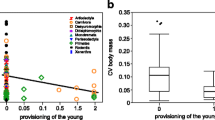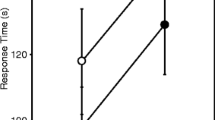Abstract
Few studies have examined potential costs of female choice and factors intrinsic to females that affect choice. To examine these factors, female house crickets, Acheta domesticus, were presented with a simultaneous choice between tapes of a priori attractive and unattractive male chirps. Females varied in age, nutritional condition, body size (potential fecundity), and size-relative reproductive investment. Female age had a significant effect on female choosiness: young females were selective, whereas older females were not selective. Nutritional condition, body size, and size-relative reproductive investment did not affect female choice. Females that chose the call of the attractive male spent approximately twice as long choosing as females that chose the unattractive male call.
Similar content being viewed by others
REFERENCES
Alatalo, R. V., Carlson, A., and Lundberg, A. (1988). The search cost in mate choice of the pied flycatcher. Anim. Behav. 36: 289–291.
Andersson, M. (1994). Sexual Selection, Princeton University Press, Princeton, NJ.
Atkins, G., Atkins, S., Schoun, D., and Stout, J. F. (1987). Scototaxis and shape discrimination in the female cricket Acheta domesticus in an arena and on a compensatory treadmill. Physiol. Entomol. 12: 125.
Backus, V. L., and Cade, W. H. (1986). Sperm competition in the field cricket Gryllus integer (Orthoptera: Gryllidae). Fla. Entomol. 69: 722–728.
Basolo, A. L. (1990). Female preference predates the evolution of the sword in swordtail fish. Science 250: 808–810.
Berglund, A. (1993). Risky sex: Male pipefishes mate at random in the presence of a predator. Anim. Behav. 46: 169–175.
Cade, W. H. (1979). Effect of male-deprivation on female phonotaxis in field crickets (Orthoptera: Gryllidae: Gryllus). Can. Entomol. 111: 741–744.
Canary 1.1. Cornell Laboratory of Ornithology, Ithaca, New York.
Crankshaw, O. S. (1979). Female choice in relation to calling and courtship songs in Acheta domesticus. Anim. Behav. 27: 1274–1275.
Csada, R. D., and Neudorf, D. L. (1995). Effects of predation risk on mate choice in female Acheta domesticus crickets. Ecol. Entomol. 20: 393–395.
Destephano, D. B., and Brady, U. E. (1977). Prostaglandin and prostaglandin synthetase in the cricket, Acheta domesticus. J. Insect Physiol. 23: 905–911.
Destephano, D. B., Brady, U. E., and Farr, C. A. (1982). Factors influencing oviposition behavior in the cricket, Acheta domesticus. Ann. Entomol. Soc. Am. 75: 111–114.
Enquist, M., and Arak, A. (1993). Selection of exaggerated male traits by female aesthetic senses. Nature Lond. 361: 446–448.
Forsgren, E. (1992). Predation risk affects mate choice in a Gobiid fish. Am. Nat. 140: 1041–1049.
French, B. W., and Cade, W. H. (1987). The timing of calling, movement, and mating in the field crickets Gryllus veletis, G. pennsylvanicus, and G. integer. Behav. Ecol. Sociobiol. 21: 157–162.
Gibson, R. M., and Bachman, G. C. (1992). The costs of female choice in a lekking bird. Behav. Ecol. 3: 300–309.
Grafe, T. U. (1997). Costs and benefits of mate choice in the lek-breeding reed frog, Hyperolius marmoratus. Anim. Behav. 53: 1103–1117.
Gray, D. A. (1997a). Female house crickets, Acheta domesticus, prefer the chirps of large males. Anim. Behav. 54: 1553–1562.
Gray, D. A. (1997b). Sexual Selection, Phenotypic and Genetic Quality in House Crickets, Acheta domesticus, Ph.D. thesis, University of New Mexico, Albuquerque.
Hack, M. A. (1997a). Assessment strategies in the contests of male crickets, Acheta domesticus (L.). Anim. Behav. 53: 733–747.
Hack, M. A. (1997b). The energetic costs of fighting in the house cricket, Acheta domesticus (L.). Behav. Ecol. 8: 28–36.
Hedrick, A. V., and Dill, L. M. (1993). Mate choice by female crickets is influenced by predation risk. Anim. Behav. 46: 193–196.
Heiligenberg, W. (1966). The stimulation of territorial singing in house crickets (Acheta domesticus). Z. Vergl. Physiol. 53: 114–129.
Heiligenberg, W. (1969). The effect of stimulus chirps on a cricket's chirping (Acheta domesticus). Z. Vergl. Physiol. 65: 70–97.
Henley, J., Greenwood, J., Stout, J., and Atkins, G. (1992). Age-correlated changes and juvenile hormone III regulation of the syllable period specific responses of the L3 auditory interneurons in the cricket, Acheta domesticus. J. Comp. Physiol. A 170: 373–378.
Iwasa, Y., Pomiankowski, A., and Nee, S. (1991). The evolution of costly mate preferences. II. The “handicap” principle. Evolution 45: 1431–1442.
Khalifa, A. (1950). Sexual behavior in Gryllus domesticus L. Behaviour 2: 264–274.
Loher, W., and Dambach, M. (1989). Reproductive Behavior. In Huber, F., Moore, T. E., and Loher, W. (eds.), Cricket Behavior and Neurobiology, Cornell University Press, Ithaca, NY, pp. 43–82.
Milinski, M., and Bakker, T. C. M. (1992). Costs influence sequential mate choice in sticklebacks, Gasterosteus aculeatus. Proc. R. Soc. Lond. B 250: 229–233.
Møller, A. P. (1994). Sexual Selection and the Barn Swallow, Oxford University Press, Oxford.
Murtaugh, M. P., and Denlinger, D. L. (1985). Physiological regulation of long-term oviposition in the house cricket, Acheta domesticus. J. Insect Physiol. 31: 611–617.
Murtaugh, M. P., and Denlinger, D. L. (1987). Regulation of long-term oviposition in the house cricket, Acheta domesticus: Roles of prostaglandin and factors associated with sperm. Arch. Insect Biochem. Physiol. 6: 59–72.
Nelson, C. M., and Nolen, T. G. (1997). Courtship song, male agonistic encounters, and female mate choice in the house cricket, Acheta domesticus (Orthoptera: Gryllidae). J. Insect Behav. 10: 557–570.
Patton, R. L. (1967). Oligidic diets for Acheta domesticus (Orthoptera: Gryllidae). Ann. Entomol. Soc. Am. 60: 1238–1242.
Pomiankowski, A. (1987). The cots of choice in sexual selection. J. Theor. Biol. 128: 195–218.
Pomiankowski, A., Iwasa, Y., and Nee, S. (1991). The evolution of costly mate preferences. I. Fisher and biased mutation. Evolution 45: 1422–1430.
Prosser, M., Murray, A.-M., and Cade, W. H. (1997). The influence of female age on phonotaxis during single and multiple song presentations in the field cricket, Gryllus integer (Orthoptera: Gryllidae). J. Insect Behav. 10: 437–449.
Real, L. A. (1990). Search theory and mate choice. I. Models for single-sex discrimination. Am. Nat. 136: 376–404.
Reynolds, J. D., and Côté, I. M. (1995). Direct selection on mate choice: Female redlip blennies pay more for better mates. Behav. Ecol. 6: 175–181.
Ryan, M. J., and Keddy-Hector, A. (1992). Directional patterns of female mate choice and the role of sensory biases. Am. Nat. 139: S4–S35.
Ryan, M. J., and Rand, A. S. (1993). Sexual selection and signal evolution: the ghost of biases past. Proc. R. Soc. Lond. B 340: 187–195.
Sakaluk, S. K. (1982). Onset of phonotaxis and age at first mating in female house crickets, Acheta domesticus (Orthoptera: Gryllidae). N.Y. Entomol. Soc. XC: 136–141.
Sakaluk, S. K., and Belwood, J. J. (1984). Gecko phonotaxis to cricket calling song: A case of satellite predation. Anim. Behav. 32: 659–662.
Sakaluk, S. K., and Cade, W. H. (1980). Female mating frequency and progeny production in singly and doubly mated house and field crickets. Can. J. Zool. 58: 404–411.
Sakaluk, S. K., and Cade, W. H. (1983). The adaptive significance of female multiple matings in house and field crickets. In Gwynne, D. K., and Morris, G. K. (eds.), Orthopteran Mating Systems: Sexual Competition in a Diverse Group of Insects, Westview Press, Boulder, CO, pp. 319–336.
Simmons, L. W. (1987). Sperm competition as a mechanism of female choice in the field cricket, Gryllus bimaculatus. Behav. Ecol. Sociobiol. 21: 129–133.
Sokal, R. R., and Rohlf, F. J. (1973). Introduction to Biostatistics, W. H. Freeman, San Francisco.
Solymar, B., and Cade, W. H. (1990). Age of first mating in field crickets, Gryllus integer (Orthoptera: Gryllidae). Fla. Entomol. 73: 193–195.
Stearns S. C. (1992). The Evolution of Life Histories, Oxford University Press, Oxford.
Stout, J., Walikonis, R., and Atkins, G. (1989a). The influence of age and JHIII levels on the sound processing characteristics of ascending auditory neurons in female crickets (Acheta domesticus). In Erber, J., Menzel, R., Pflüger, H. J., and Todt, D. (eds.), Neural Mechanisms of Behavior, Thieme Medical, New York.
Stout, J., Walikonis, R., and Atkins, G. (1989b). The influence of age and JHIII levels on the phonotactic response of female crickets (Acheta domesticus). In Erber, J., Menzel, R., Pflüger, H. J., and Todt, D. (eds.), Neural Mechanisms of Behavior, Thieme Medical, New York.
Stout, J., Atkins, G., and Zacharias, D. (1991). Regulation of cricket phonotaxis through hormonal control of the threshold of an identified auditory neuron. J. Comp. Physiol. A 169: 765–772.
Ten Cate, C., and Bateson, P. (1988). Sexual selection: The evolution of conspicuous characteristics in birds by means of imprinting. Evolution 42: 1355–1358.
Ten Cate, C., and Mug, G. (1984). The development of mate choice in Zebra finch females. Behaviour 90: 125–150.
Thornhill, R. (1984). Alternative female choice tactics in the scorpionfly Hylobittacus apicalis (Mecoptera) and their implications. Am. Zool. 24: 367–383.
Walikonis, R., Schoun, D., Zacharias, D., Henley, J., Coburn, P., and Stout, J. (1991). Attractiveness of the male Acheta domesticus calling song to females III. The relation of age-correlated changes in syllable period recognition and phonotactic threshold to juvenile hormone III biosynthesis. J. Comp. Physiol. A 169: 751–764.
Weisman, R., Shackleton, S., Ratcliffe, L., Weary, D., and Boag, P. (1994). Sexual preferences of female Zebra finches: Imprinting on beak color. Behaviour 128: 15–24.
Woodring, J. P., Clifford, C. W., and Beckman, B. R. (1979). Food utilization and metabolic efficiency in larval and adult house crickets. J. Insect Physiol. 25: 903–912.
Author information
Authors and Affiliations
Rights and permissions
About this article
Cite this article
Gray, D.A. Intrinsic Factors Affecting Female Choice in House Crickets: Time Cost, Female Age, Nutritional Condition, Body Size, and Size-Relative Reproductive Investment. Journal of Insect Behavior 12, 691–700 (1999). https://doi.org/10.1023/A:1020983821436
Issue Date:
DOI: https://doi.org/10.1023/A:1020983821436




